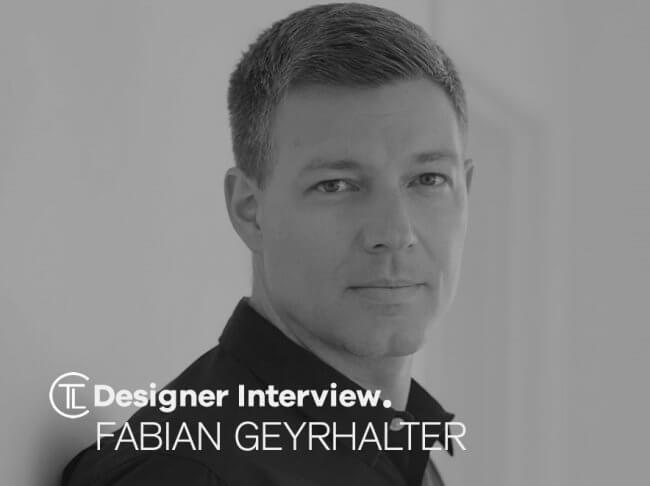
Fabian Geyrhalter was born in Vienna, Austria and is a graduate of ArtCenter College of Design. He is a renowned Brand Strategist and Founder and Principal of FINIEN.
Fabian is a columnist for Inc and Forbes and his thoughts on branding have been published by the likes of The Washington Post, Mashable, Entrepreneur and The Huffington Post.
Designer Interview With Fabian Geyrhalter @FINIENInsights #designerinterview #logodesign #branding
https://t.co/MXAOcx4TbD pic.twitter.com/PT2WuDo3my— The Logo Creative™ (@thelogocreative) June 13, 2018
A frequent speaker at conferences and universities worldwide, he holds branding workshops at incubators and corporations and a mentor to entrepreneurs worldwide, he is a “Global 100” mentor at the Founder Institute and author of the #1 Amazon Bestseller “How to Launch a Brand.”
Fabian regularly judges international design competitions and is an active jury member of the Academy of Interactive & Visual Arts. His branding work has won numerous accolades, including 30 “American Graphic Design Awards.”

Fabian is an Advisory Board Member of Santa Monica College and served as an adjunct professor at USC and Art Center College of Design. He is further serving as consulting Executive Creative Strategist at Urban Insight, a leading technology consulting firm, managing the intersection of brand vision and creative digital strategy.
His consultancy’s client list ranges from high-growth startups such as Jukin Media, Survios, and Vimmia to established brands like Warner Brothers, The Bill & Melinda Gates Foundation, Goodwill, W Hotels and Honeywell.
The Logo Creative – Hello Fabian it’s a pleasure to be featuring you in our designer interviews
Fabian Geyrhalter – This is fantastic, thanks, Andrew
The Logo Creative – What was the turning point in your life when you decided to become a designer and how did you proceed?
Fabian Geyrhalter – I knew it rather early on. I always drew and I started designing in High School. I was also very active socially and organized events for which I designed flyers and posters. When it was time to decide whether to pursue a professional snowboarding career or go study at ArtCenter College of Design, my parents swiftly opted for the latter. It likely saved my life.
The Logo Creative – What does your day consist of?
Fabian Geyrhalter – Ever since I transitioned from being a hands-on designer behind the screen to being more involved in creative direction and brand strategy, luckily my days are not too much of a routine as I travel a lot for speaking engagements, brand strategy workshops or client meetings, but those few days a week where I am at the office, I usually spend 50% on client calls and strategy projects, 30% on art direction and the other 20% on writing my thoughts on branding, PR and new business.
The Logo Creative – Are you a morning person or night owl and is there a reason why?
Fabian Geyrhalter – I used to be a night owl, back when I was hands-on designing. I feel that is the norm for young designers in the profession. When I decided that I can’t keep running crazy long hours to reach design perfection while risking my health and sanity I changed to a rather balanced lifestyle. I usually get up around 6:30 AM and go to bed around 11:00 PM, so yes, I might be one of the few people you interview that actually cherish their sleep. I am pretty religious about my 7.5 hours exact and I love arriving at my desk by 8:00 AM to ease into the day.
The Logo Creative – What was the first logo you ever designed?
Fabian Geyrhalter – Oh boy, that really catapults me back down memory lane. I always designed logos from as young as 8 years old. Some were tags based on my initials, but the first officially ‘published’ logo may have been the one I did for myself when I was throwing events under the uninspired name of FAB PROMOTIONS. I must have been 15 at the time. Obviously, I was not a big naming expert back then.
The Logo Creative – What is your favourite logo you have designed?
Fabian Geyrhalter – As a hands-on designer I really still enjoy the logo I did for real estate company OPAL, which ached to be seen as a large player in the field while they were still growing into that space. I did that 14 years ago and it still holds up rather nicely.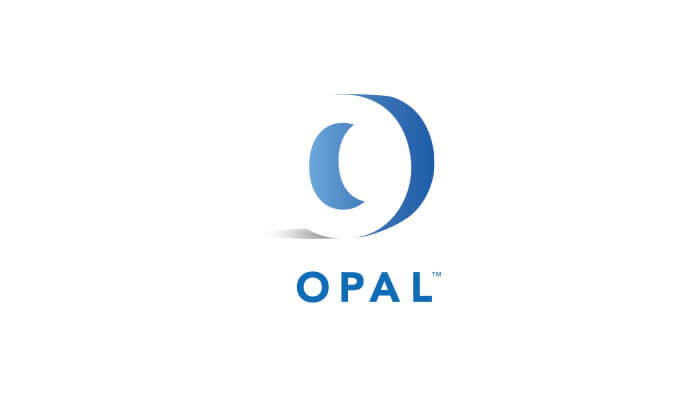 With my company, FINIEN, as a Creative Director, it may be JUKIN Media, a company that finds and blows up videos into virality – I love the logo for its impact and concept: A company that stands in the shadow of the video creators, white type on white background, and it sees something bold and red being magnified out of nothing.
With my company, FINIEN, as a Creative Director, it may be JUKIN Media, a company that finds and blows up videos into virality – I love the logo for its impact and concept: A company that stands in the shadow of the video creators, white type on white background, and it sees something bold and red being magnified out of nothing.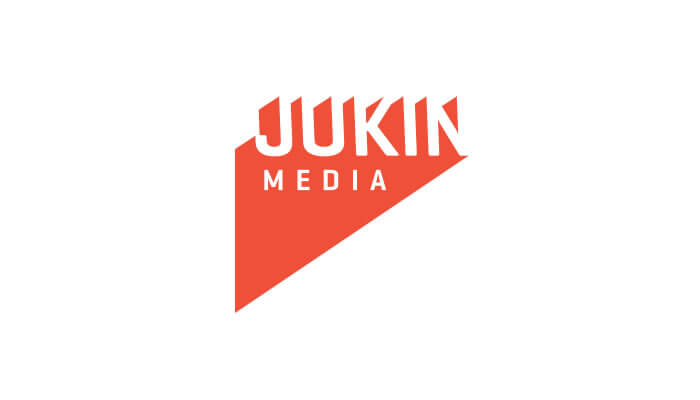 Here are some more that we put together to celebrate the past 5 years of logo creations:
Here are some more that we put together to celebrate the past 5 years of logo creations:
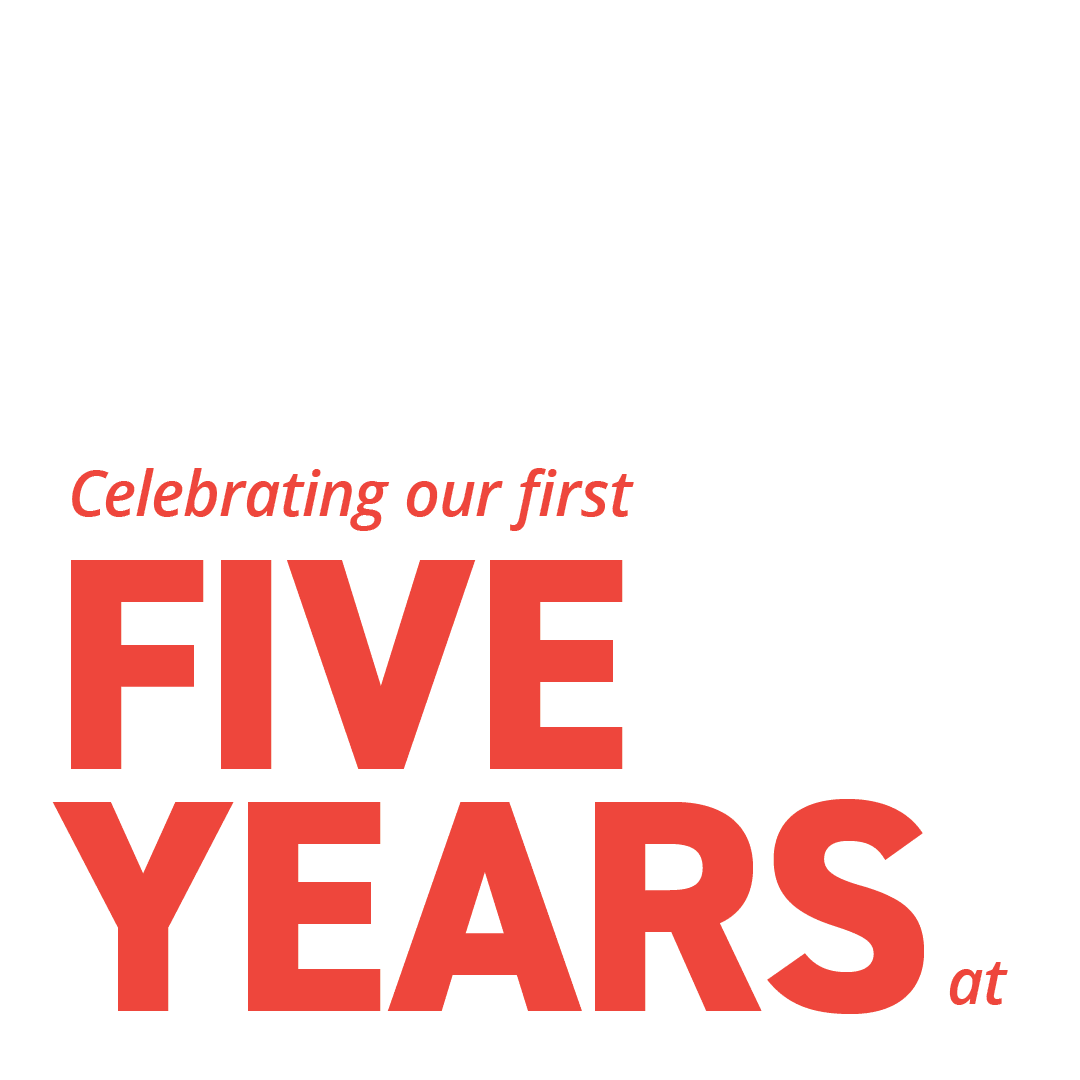
The Logo Creative – What are your favourite logos of all time?
Fabian Geyrhalter – This is nothing short of naming your favourite song; it is impossible to do. But just to give you an answer, I do love simplicity and meaning – if you are able to pull that off, you are already a logo Rockstar. Montblanc’s striking logo comes to mind as it signifies the peak of its namesake mountain while immediately conjuring the iconic pen with its logo on top.

Just the other day though, as I was reviewing the graduation showcase at my alma mater, ArtCenter College of Design, where I also taught, this logo by a student struck me so much that I still can not stop thinking about it. It was a logo for the famous Griffith Observatory in the Hollywood hills. The way she worked the letterform to use the white space of the letter ‘g’ and repurpose it to hint at the act of observing as well as the star, is nothing short of logo poetry.
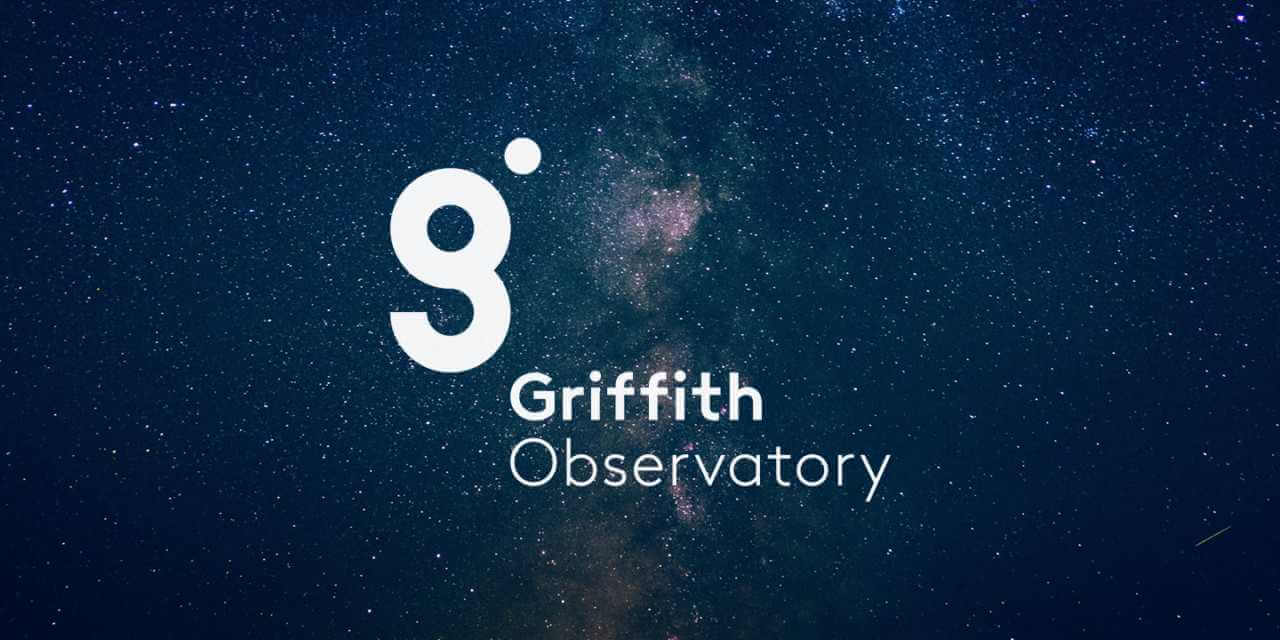
http://sandraseo.com/griffith-observatory/
The Logo Creative – Can you describe or give us an overview of your logo design process?
Fabian Geyrhalter – I won’t bore you with specifics as every designer goes through a somewhat similar process of designing, evaluating and presenting, but the key takeaway is that the longer I am in this business the faster we get to a solution. And the longer we do this the better the design solution gets. And this is solely because we learn to ask the right questions to the right people early on. That really is the secret sauce to solving any service business question and with identity design it is the most overlooked yet most crucial piece of the puzzle: Get the stakeholder, and I mean the true stakeholder, the CEO’s and VP’s of the companies, involved; guide them through very specific strategic questions and you will have not only the answers that will help you create a solution rather swiftly, but you will also have given them a feeling of ownership in the outcome and therefore gain quick buy-in. To me, that’s key to our process, and a differentiator, and it makes it really enjoyable, even after 24 years of doing so.
The Logo Creative – What brands do you most admire and how do they influence your creative thinking?
Fabian Geyrhalter – Brands that continuously innovate and experiment, yet always stay true to their brand DNA. Patagonia, Nike, Starbucks come to mind. Those are big American consumer brands, but especially because of that, it is inspirational that they are nimble enough to change yet never lose focus of their core brand DNA. Look at Apple, a brand that fell off my list a few years ago as they have lost that special sauce; they acted against the brand DNA their audience so believed in.
The Logo Creative – What do you consider your most successful design project, and why?
Fabian Geyrhalter – Re-designing my design agency into a brand consultancy. It was the riskiest project I ever took on and I was a rather determined client to see a very specific outcome. It was a re-design of my life, it was important, and it was well executed, from strategy to naming, visual and verbal identity all the way to implementation.

The Logo Creative – How long does it take to complete the average logo design project from start to finish?
Fabian Geyrhalter – 4 weeks.
The Logo Creative – What are your recommended design books to read?
Fabian Geyrhalter – How to Launch a Brand, not because I wrote it, ok, perhaps also because I wrote it, but it really is a nice primer for anyone to follow the steps and logic necessary to craft a brand strategy, create a brand name and follow through with an overarching brand identity design.
Designing Brand Identity by Alina Wheeler is also a wonderful book, and, of course, anything by Marty Neumeier if you are not afraid to cross into brand strategy a bit.
The Logo Creative – What is your favourite style of logo design? And why?
Fabian Geyrhalter – Using negative space to convey an added, subliminal message.
The Logo Creative – What was the biggest challenge you ever faced on a project?
Fabian Geyrhalter – A long time ago, when I was still running my design agency (rather than the current brand consultancy), I did a handshake deal with a serial entrepreneur friend of mine to design a logo for his company. That turned into more work; much more work. He ended up investing in a number of hotels and I ended up hiring a lot of new people as we were working on creating brands and designing everything from the logo, signage to the restaurant menu and the ‘do not disturb’ door tags.
We were going at full speed, my payroll kept going up and it all ended overnight when I had to let go of a person. That person knocked on the client’s door the next day, he hired her and subsequently stopped paying our bills. All of it was my fault as I did not play by the standard rules of business – I had subpar employee contracts and no client contract. There was a lot of trust. It was years of organic growth and it was inexcusably stupid of me. It was the most stressful time of my life to cling on to the agency I built for over a decade and none of my clients knew any of this occurred. It taught me the tough lessons of business, all at once and all overnight.
I guess that counts as a rather challenging project.
The Logo Creative – In your opinion what’s the best and worst part of your job as a designer?
Fabian Geyrhalter – The best part is being able to give birth to something new and meaningful all the time. To realize your vision. To inspire others. To solve problems. To create beauty. To learn about new businesses. To better businesses.
The worst is that it’s usually a highly competitive, underpaid, underappreciated and tough line of work these days. A big reason I started to shift my focus to brand strategy, but my heart still beats strongly for design and we are still creating exceptional (if I say so!) logo work.
The Logo Creative – Who is the most inspiring person to you and why?
Fabian Geyrhalter – If I would answer this, I would not be able to look my wife in her face, call my mum, share a glass of wine with my dad, or meet any peers that serve as mentors. With that being said, I will strategically pass on this question.
The Logo Creative – Who is your favourite graphic designer and why?
Fabian Geyrhalter – I don’t have one. I have favourite artists and favourite communication design solutions. I have favourite product and car designers, but graphic designers that are focused on a particular style do not speak to me as I am too fixated on the idea of graphic design being less of an expression of art and more of a strategic solution that needs to look different from client to client and audience to audience.
The Logo Creative – What’s your favourite design quote or quote in general, and do you have a mantra or saying you live by?
Fabian Geyrhalter – A quote I enjoyed a lot when I saw it recently on Twitter (it was posted by a startup we branded, Mister Maginsky, which I am also a stakeholder in):
“Adapt what is useful, reject what is useless, and add what is specifically your own.” – Bruce Lee
My mantra is to say no, and, say it often. It keeps me from doing work that is not a perfect fit.
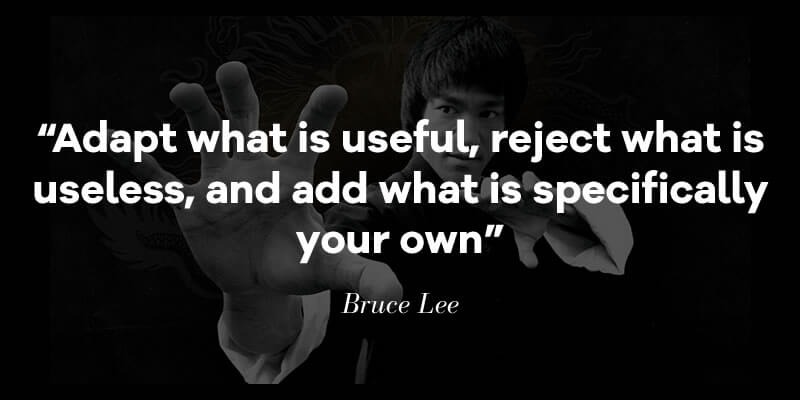
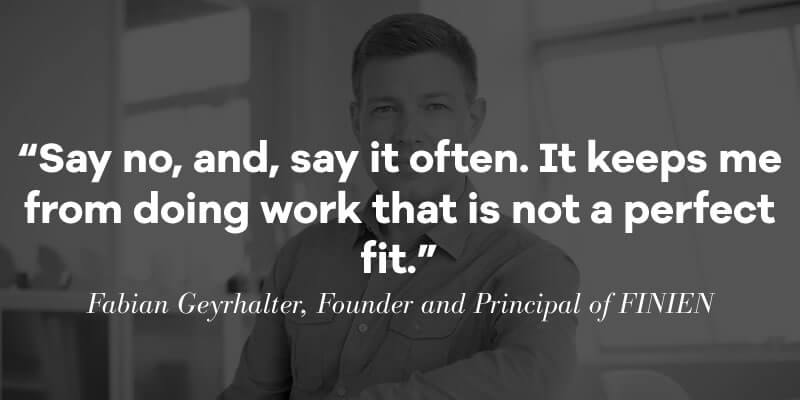
The Logo Creative – In less than 10 words what is graphic design?
Fabian Geyrhalter – Not less than, but exactly 10:
Using visual language to convey a message and trigger action.
The Logo Creative – What steps did you take to start your graphic design business? Did you have to make any sacrifices on your journey?
Fabian Geyrhalter – I was a workaholic – and driven by passion and a quest for perfection. I worked as a Creative Lead at a digital agency working on the online design for luxury car brand Acura and I was waiting for my Green Card to hit in. So, while I was hustling to be a digital designer (I was coming from a print background, so there was a lot of learning while doing going on), I was also acquiring freelance clients so that I could start my own business the minute the Green Card gets issued. Sure enough, that plan worked out and I quit the day the card arrived and started right off the bat working for clients like MGM out of my studio in Venice. I hired an intern (now a big designer at Google in Silicon Valley) and I remember how she was working with me out of a converted garage with my cat running around; it was kind of ridiculous. She turned into my first full-time hire and a few years later into my first Senior Designer. At that point, I already moved into a nice office space in a prime location in Santa Monica with a small staff, one block from the beach, but it was hard work. Many sleepless nights and almost only 10-12 hour days, rarely full weekends for years and years. There was a lot of anxiety and burnout as much as there were joy and creative expression.
The Logo Creative –Do you have any regrets? Is there anything you would have changed early on in your career?
Fabian Geyrhalter – Oh absolutely! Like most designers I was keen on doing 110% amazing work 110% of the time when the truth is that most clients are happy with 80% as they do not comprehend the 30 extra percent you put in (because they are not trained like you are), which is keeping you from having a balanced life. It’s a silly practice that feels a bit selfish – we do it for industry acceptance. It’s a bit like all those dumb commercials you see, where you wonder what in the world they mean and then you realize it was likely made by some Ad Agency Art Director, high as a kite on anything but life, with the single strategy to do something so weird and different that (s)he may finally have a chance of winning that big fat industry award. And us viewers, and often the client, we all have to suffer. (OK, end of that rant.)
I also wish I had spent time (or have gotten the opportunity of) studying business and management.
I wish I had been more selective with the work I took on, to always get paid the exact value that I thought the work ought to have.
I could go on, but you know, at the end of the day these are the moments that inform you as a person and I believe because I went through so many (sometimes painful) growth moments in my business, I was able to pivot to being a well-rounded consultant who now very well understands business and the art of positioning. I feel that many designers would have a hard time making the move over to brand strategist without having dealt with so many business situations, especially the tough ones.
The Logo Creative – What’s the most important piece of advice you have received as a designer that’s helped you?
Fabian Geyrhalter – If it has no concept, it is art and not design, hence useless for a client as it does not meet the objective. Unless the objective was to create something pretty.
The Logo Creative – What would be your advice for new Logo and Graphic Designers?
Fabian Geyrhalter – Think like an entrepreneur with every action you take and with every question you ask your client.
Bonus Questions
I would like to thank Fabian for sending us a signed copy of both his books “How to launch a brand” and “Bigger than this” Below we ask him some bonus questions about his new book “Bigger than this”
The Logo Creative – What inspired you to write “Bigger than this”?
Fabian Geyrhalter – I came across startups that did not lead with design or tech innovation – they were really commodity product based – but yet people went crazy for them and they quickly turned into admired brands.
I am talking about products such as traditional footwear, plain socks, unchanged office supplies. As someone obsessed with the art and science of branding, this fascinated me, so I studied these companies to see what one can learn from how they go about branding as that is their one and only true differentiator. I distilled my findings into 8 traits any business can learn from and so a book was born.
The Logo Creative – Your first book “How to Launch a Brand: Your Step-by-Step Guide to Crafting a Brand: From Positioning to Naming and Brand Identity was a #1 Amazon bestseller. Would you recommend people to read your first book before reading “Bigger Than This”?
Fabian Geyrhalter – It really depends on where they are at in their branding journey. If you are just starting out, I’d say read How to Launch a Brand and Bigger Than This simultaneously to craft the perfect brand from inside out. If you are running a company, or you are a marketer working with a specific brand, and you feel it requires a deeper meaning in order to retain talent and to compete better in today’s marketplace, I would recommend Bigger Than This.
The Logo Creative – In your personal opinion, what do you think are the essential building blocks of an authentic brand? And once this foundation is in place how do you best leverage it?
Fabian Geyrhalter – Any brand is born with authenticity in tow, so the real question is: How do you get to the heart of it and translate it in a way that transforms your venture into a brand your staff identifies with and customers fall in love with? The key is to define your AND?DNA in order to arrive at your BRAND!DNA. Start by asking questions like: “And why would a consumer deeply care about your offering?” “And how do you tell a bigger, relatable and sustainable story around your offering that can turn it into a beloved brand?” “And why do you and, if applicable, your employees devote your time to this particular offering, turning it from simply a day job into a daily passion with all of your heart and soul?”
The Logo Creative – For those preparing to launch a new brand how will “Bigger than this” help them?
Fabian Geyrhalter – It will inspire them to find a specific way to stand for something that is more important, deeper, and more relatable to their audience then just the product/service offering alone. It really helps in finding the one specific brand connection point that feels intrinsic to the reader and their offering. Finding it, defining it and making it a big part of their launch can be a game changer for initial customer acquisition and their business growth. To me, branding is a layer of insurance for any organization: Competitors can take away everything from you, from a specific product feature all the way to your staff, but they cannot steal your soul; that is your branding; that is bigger than this [the product].
The Logo Creative – Within the book “Bigger than this” you encourage brands to embrace 8 simple traits – story, belief, cause, heritage, delight, transparency, solidarity, and individuality; could you briefly describe them.
Fabian Geyrhalter – Readers can take one, or more, of these traits and start embodying them in their own brand. You can lead with an amazing story like Fishpeople Seafood who ‘put people back into the seafood industry,’ or be based on a strong belief like Austrian-based shoe-manufacturer GEA, which publishes a very opinionated political newspaper. You can support a cause that is so linked to your product that your audience buys into the cause first and your product second, as is the case with Bombas, which gives a pair of socks to homeless for every pair sold because homeless shelters cannot accept donated socks. You can be like Shinola and make a location your brand core, or like Poppin and disrupt a mundane industry (office supplies in this case) through sheer use of fun language and colours. Or you can be like Everlane and lead through radical transparency, hence turning into a brand that will be instantaneously trusted by its audience. You can lead with solidarity and be like Planet Fitness, whose gyms serve candy at the front door and make their franchises a ‘judgement free zone.’ Or Fanatics, who celebrate the brand trait of individuality by printing custom fan t-shirts the moment a sports game ends.
As you can tell, these are all startups that chose one key brand trait and despite lacking huge innovation or technological advantages, they leaped ahead of their competitors and gave customers a reason to fall in love with their brand. To me, that is powerful brand thinking that any startup or Fortune 500 can learn from in order to turn into a more admired brand.
The Logo Creative – In your personal opinion what makes a great identity system?
Fabian Geyrhalter – Simplicity and foresight. Simplicity in the design so it turns memorable and iconic but also lends itself to iterations for an expanding brand architecture. And foresight to ensure the system can continuously visually and conceptually expand without getting too repetitive, stale or confusing.
The Logo Creative – How do the best brands go about building trust with consumers?
Fabian Geyrhalter – They earn it by walking the walk. Like good friends they say ‘sorry’ when they screw up and like good people they do selfless things – that don’t immediately help the bottom line – in order to make this place called earth we share a better, or at least not a worse, place to inhabit.
The Logo Creative – How can we use strategy as part of our design process?
Fabian Geyrhalter – How can you not? Always make every design project a reason to push a brand forwards, to deeper connect with an audience and to bring a glimpse of joy to the recipient.
The Logo Creative – Should brand storytelling be the foundation of a brands growth strategy?
Fabian Geyrhalter – All great brands are great storytellers, but a brand will only see growth if it has found a focus on what it stands for, what its DNA is made out of that connects with its audience. At the heart, it is brand positioning, or if you’d ask Simon Sinek, in even simpler terms, it is answering the question Why before the Who, the What, and the How. Then you tell the story of that brand DNA over and over again, in all kinds of different ways. It never gets stale if it is meaningful to your audience. That is why a Patagonia is a Patagonia and a Nike is a Nike, and that formula is applied, on a shoe-string budget, by these smart new startups that don’t even innovate, but they understand how to create a bond with a group of likeminded humans.
learn more about Fabian Geyrhalter | www.finien.com | eRESONAID |
Check out designers interview discussion on Linkedin
Join The Logo Creative LinkedIn Group | Join Our Community Server

